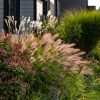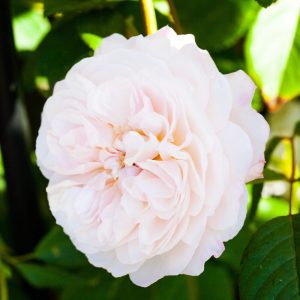Description
Pennisetum alopecuroides, commonly known as fountain grass, is an ornamental grass that grows in dense clumps up to 1.2 meters in height and spread. The leaves are narrow, arching and dark green in color, turning golden-yellow in autumn. In late summer to early autumn, fluffy bottlebrush-like inflorescences appear above the foliage, ranging in color from creamy white to pale pink or purple, depending on the cultivar. These attractive flowers persist well into winter and can be used for dried flower arrangements. Pennisetum alopecuroides is a hardy, low-maintenance plant that is drought-tolerant once established and grows well in full sun to partial shade. It is suitable for use as a specimen plant, in mass plantings, as a ground cover, or in mixed borders. It can be paired with other ornamental grasses, such as Miscanthus or Panicum, as well as perennials like Rudbeckia and Echinacea.
Key Facts
- Common Name(s):Chinese fountain grass
- Hardiness:Half hardy and would benefit from protection through Winter.
- How big will I get? Pennisetum alopecuroides can grow to a height of 1.2m and a spread of 1.2m.
- Did You Know That:The Latin specific epithet alopecuroides means similar to Alopecurus which is the Foxtail genus?
Plant Calendar
A rough guide to how this plant will change through the year.
| Jan | Feb | Mar | Apr | May | June | July | Aug | Sept | Oct | Nov | Dec | |
| Flowering Time |   |
  |
||||||||||
| Foliage Colour |  |
 |
 |
 |
 |
 |
 |
 |
 |
 |
 |
 |
| J | F | M | A | M | J | J | A | S | O | N | D |
  |
  |
||||||||||
 |
 |
 |
 |
 |
 |
 |
 |
 |
 |
 |
 |
Care Guide

Soil Requirements
Pennisetum alopecuroides prefers soil with good drainage and does not tolerate standing water. This plant can grow in soil with a wide range of pH levels, it is not picky about the pH level of the soil.

Best Position
Pennisetum alopecuroides prefers a sheltered position and requires full sun to thrive, this consists of more than six hours of direct sunshine per day.

Maintenance
Pennisetum alopecuroides will benefit from any dead foliage being removed in Winter or early Spring and can also be trimmed lightly as needed. This will keep the plant looking nice and healthy and promote fresh growth emerging as Spring progresses.

Pest, Diseases and Wildlife
Pennisetum alopecuroides is generally pest free, and it tends not to have problems with diseases.no. It is not considered to be toxic.







